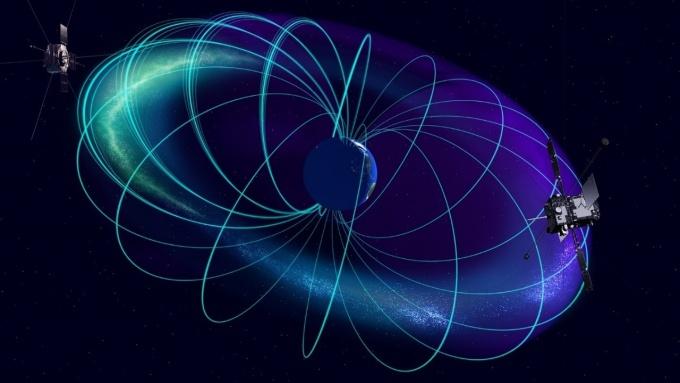
Credit: ERG Science Team
A collaboration between researchers in Japan, the USA, and Russia has found a hot spot in Earth’s radiation belt where killer electrons, which can cause serious anomalies in satellites, form. The finding, published in the journal Geophysical Research Letters, could help scientists more accurately forecast when these killer (relativistic) electrons will form.
Professor Yoshizumi Miyoshi of the Institute for Space-Earth Environmental Research at Nagoya University and colleagues compared data from two satellites situated on opposite sides of the Earth: the Arase satellite, developed by the Japanese Aerospace Exploration Agency (JAXA), and NASA’s Van Allen Probes. Both satellites gather data from the Van Allen radiation belts, zones of energetic particles originating largely from solar wind. Energetic particles in the belts are trapped by Earth’s magnetic field.
Scientists have known that electrons in Van Allen radiation belts that interact with ultralow frequency plasma waves accelerate to reach the speed of light. However, it has not been clear when or where these killer electrons start to accelerate.
To gain more insight about the electrons, Professor Miyoshi and his colleagues analyzed data generated on March 30, 2017, by the Arase satellite and Van Allen Probe. On one side of the Earth, the Van Allen Probe identified characteristic signs of an interaction between ultralow frequency waves and energetic electrons. On the opposite side, at the same point in time, the Arase satellite identified high-energy electron signatures, but no ultralow frequency waves.
The measurements indicate that the interaction region between electrons and waves is limited, but that the killer electrons then continue to travel on an eastward path around the Earth’s magnetosphere.
“An important topic in space weather science is understanding the dynamics of killer electrons in the Van Allen radiation belt,” says Miyoshi. “The results of this study will improve the modelling and lead to more accurate forecasting of killer electrons in Van Allen radiation belts.”
###
The article, “Remote Detection of Drift Resonance Between Energetic Electrons and Ultralow Frequency Waves: Multisatellite Coordinated Observation by Arase and Van Allen Probes,” was published in Geophysical Research Letters on November 6, 2019, at DOI: 10.1029/2019GL084379
For more information, contact:
Professor Yoshizumi Miyoshi
Institute for Space-Earth Environmental Research, Nagoya University
Email: [email protected]
About Nagoya University
Nagoya University has a history of about 150 years, with its roots in a temporary medical school and hospital established in 1871, and was formally instituted as the last Imperial University of Japan in 1939. Although modest in size compared to the largest universities in Japan, Nagoya University has been pursuing excellence since its founding. Six of the 18 Japanese Nobel Prize-winners since 2000 did all or part of their Nobel Prize-winning work at Nagoya University: four in Physics – Toshihide Maskawa and Makoto Kobayashi in 2008, and Isamu Akasaki and Hiroshi Amano in 2014; and two in Chemistry – Ryoji Noyori in 2001 and Osamu Shimomura in 2008. In mathematics, Shigefumi Mori did his Fields Medal-winning work at the University. A number of other important discoveries have also been made at the University, including the Okazaki DNA Fragments by Reiji and Tsuneko Okazaki in the 1960s; and depletion forces by Sho Asakura and Fumio Oosawa in 1954.
Media Contact
Yoshizumi Miyoshi
[email protected]
Original Source
http://en.
Related Journal Article
http://dx.




